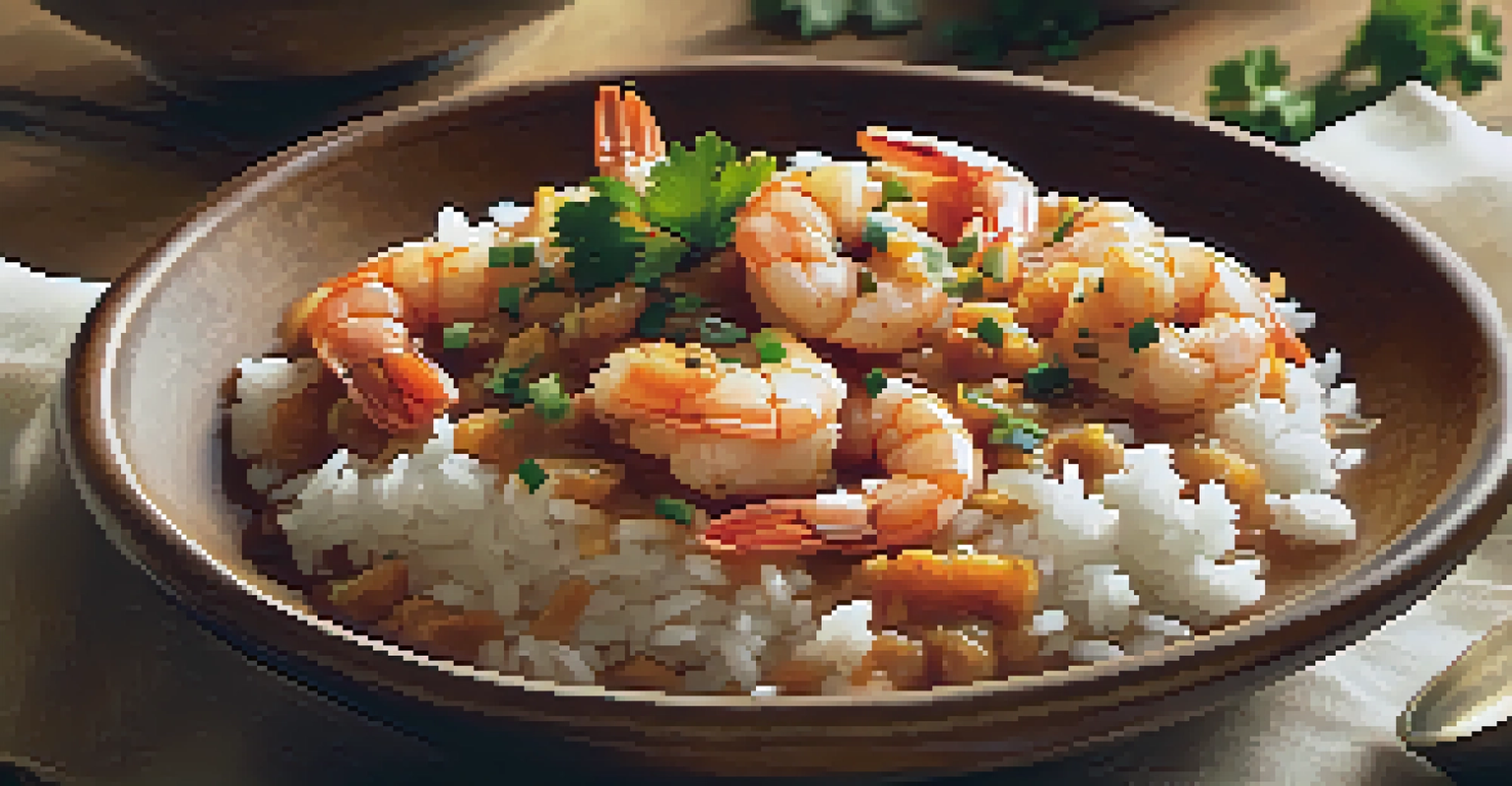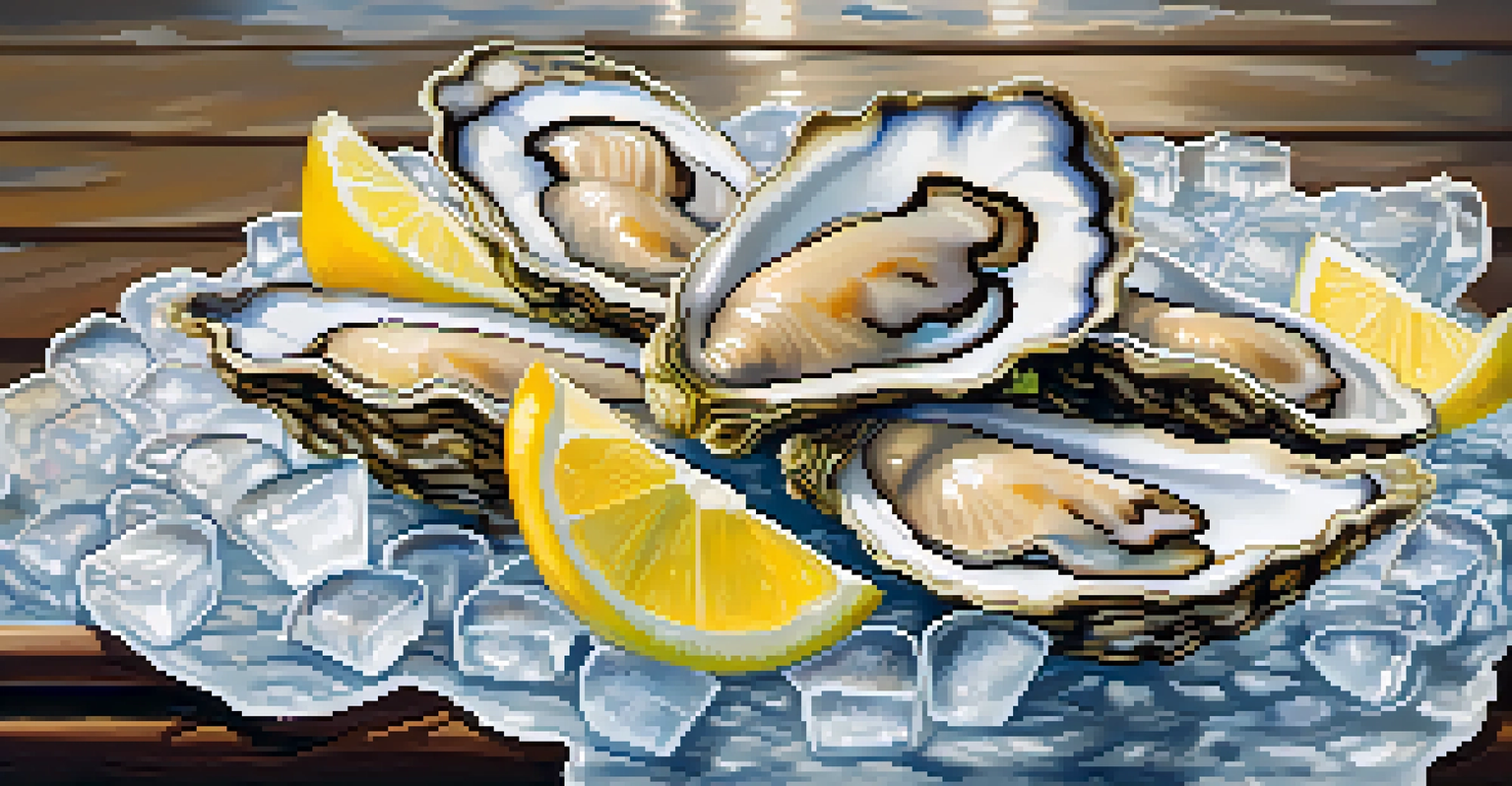The Role of Seafood in New Orleans' Culinary Traditions

New Orleans: A Seafood Lover's Paradise
New Orleans is often celebrated as a food lover's haven, and seafood plays a starring role in this culinary landscape. With its location along the Gulf of Mexico and proximity to rich fishing waters, the city has access to a diverse array of fresh seafood. From shrimp to oysters, the abundance of local catches inspires chefs and home cooks alike. This connection to the sea not only enriches the local diet but also reflects the city's cultural heritage.
Food is our common ground, a universal experience.
Seafood isn't just a meal in New Orleans; it's a way of life. The city's unique blend of cultures, including Creole, Cajun, and French influences, creates a vibrant tapestry of flavors. For instance, the iconic gumbo showcases a delightful mix of seafood, spices, and vegetables, making it a beloved dish that's often passed down through generations. Each bowl of gumbo tells a story, one that's deeply intertwined with the region's fishing traditions.
From the bustling French Market to the upscale restaurants in the Garden District, seafood can be found in various forms throughout the city. This accessibility ensures that both locals and visitors can enjoy the freshest seafood, prepared in ways that celebrate New Orleans' culinary traditions. Whether it's a low-key crawfish boil or a fancy grilled redfish dish, seafood unites the community around the dinner table.
Crawfish: The Jewel of New Orleans Seafood
When it comes to seafood in New Orleans, crawfish holds a special place in the hearts of locals. This small crustacean is not only a staple during the spring season but also a symbol of community gatherings and celebrations. Crawfish boils, where friends and family come together to enjoy the catch, exemplify the city's social fabric. It's an experience filled with laughter, stories, and, of course, delicious food.

The preparation of crawfish is as much about the process as it is about the taste. Traditionally, these little guys are boiled with a mix of spices, potatoes, corn, and sometimes sausage, creating a feast that's both flavorful and fun. The act of peeling crawfish becomes a communal activity, bringing people closer together in the process. It's a hands-on experience that embodies the essence of New Orleans hospitality.
Seafood Shapes New Orleans Culture
The rich seafood traditions in New Orleans reflect its diverse cultural heritage and create community connections through shared culinary experiences.
Moreover, crawfish dishes extend beyond the boil. Chefs creatively incorporate this seafood into etouffée, pastas, and even tacos, showcasing its versatility. As a result, crawfish not only serves as a seasonal delicacy but also as a canvas for culinary innovation, allowing New Orleans chefs to honor tradition while embracing new flavors.
Oysters: A Coastal Delicacy with a Twist
Oysters are another cornerstone of New Orleans' seafood culture, known for their unique flavor and texture. Whether enjoyed raw on the half shell or cooked in a rich oyster stew, these briny delights are a must-try for anyone visiting the city. The local practice of eating oysters is steeped in tradition, with many establishments boasting their own secret recipes and styles of preparation.
You don't have to cook fancy or complicated masterpieces – just good food from fresh ingredients.
One of the most popular oyster dishes in New Orleans is the infamous oyster po' boy, a sandwich that encapsulates the city's culinary spirit. With crispy fried oysters tucked into a crusty French bread and topped with lettuce, tomato, and a tangy sauce, it’s a handheld feast that locals cherish. This dish showcases how oysters can be elevated from a simple appetizer to a satisfying meal, reflecting the city's resourcefulness in using local ingredients.
Additionally, the cultural significance of oysters extends to local events like the Oyster Festival, where the community comes together to celebrate this beloved seafood. With live music, culinary demonstrations, and endless oyster dishes to sample, it highlights the importance of oysters in New Orleans’ food scene. This celebration not only honors the seafood itself but also the people who bring it to life through sustainable practices and innovative cooking.
Gumbo: A Seafood Symphony in a Bowl
Gumbo is often considered the quintessential New Orleans dish, and seafood is a key player in its rich, flavorful ensemble. This hearty stew typically features a blend of shrimp, crab, and sometimes oysters, all simmered in a savory broth. The combination of spices and ingredients reflects the city's diverse culinary heritage, making each pot of gumbo a unique work of art.
The preparation of gumbo involves creating a roux, which serves as the base for the dish. This process of slowly cooking flour and fat to a deep brown color is both an art and a science. The roux adds depth and complexity to the dish, harmonizing beautifully with the seafood and other ingredients. It’s an essential step that connects cooks to generations of tradition and expertise in New Orleans cuisine.
Crawfish: A Symbol of Community
Crawfish boils are a quintessential social gathering in New Orleans, showcasing the importance of togetherness and celebration around food.
What makes gumbo truly special is its adaptability. Each family may have its own recipe, passed down through generations, adding personal touches and regional variations. This flexibility allows chefs to experiment with seasonal seafood, ensuring that gumbo remains a living tradition that evolves with the ingredients available. In a city where food is a celebration of culture, gumbo stands out as a beloved dish that brings everyone together.
Shrimp: The Versatile Star of the Plate
Shrimp is perhaps the most celebrated seafood choice in New Orleans, thanks to its accessibility and versatility. From shrimp scampi to shrimp and grits, there’s no shortage of dishes that showcase this delightful crustacean. What makes shrimp so appealing is not just its flavor, but also the ease with which it can be cooked and incorporated into various recipes, making it a favorite for both professional chefs and home cooks.
One of the most iconic dishes featuring shrimp is the classic shrimp étouffée, which combines the sweetness of shrimp with a rich, flavorful sauce. This dish is typically served over rice, allowing the sauce to soak in, creating a comforting meal that warms the soul. The layering of flavors in étouffée exemplifies the culinary prowess found in New Orleans, showcasing the city's ability to elevate simple ingredients into something extraordinary.
Beyond traditional dishes, shrimp also plays a role in the evolving culinary scene of New Orleans. Chefs are constantly pushing the boundaries, creating innovative takes on classic recipes or even incorporating shrimp into fusion cuisine. This adaptability ensures that shrimp remains a beloved staple on menus throughout the city, celebrating the region's fishing heritage while embracing the future of culinary creativity.
Sustainable Seafood Practices in New Orleans
As the seafood industry evolves, so does the need for sustainable practices to protect marine ecosystems. In New Orleans, many chefs and fishermen are committed to sourcing seafood responsibly, ensuring that future generations can continue to enjoy this culinary treasure. Sustainable seafood involves practices that minimize environmental impact, such as responsible fishing methods and supporting local fisheries.
Restaurants in the city are increasingly highlighting their commitment to sustainability by featuring dishes made from locally sourced seafood. This not only ensures freshness but also supports the local economy and reduces the carbon footprint associated with transporting seafood. Diners can feel good knowing that their meals contribute to the health of the oceans and the livelihoods of local fishermen.
Sustainability in Seafood Practices
Local chefs and fishermen are committed to sustainable practices, ensuring that New Orleans' seafood traditions can thrive for future generations.
Sustainability also extends to educational initiatives in New Orleans, where organizations work to raise awareness about the importance of protecting marine resources. Workshops, cooking classes, and community events emphasize the significance of making informed choices when it comes to seafood. By fostering a culture of sustainability, New Orleans is setting an example for other culinary scenes, proving that delicious food and environmental responsibility can go hand in hand.
The Future of Seafood in New Orleans Cuisine
Looking ahead, the future of seafood in New Orleans cuisine is both exciting and promising. As chefs continue to innovate and experiment, we can expect to see new flavors and techniques that honor the city's rich culinary heritage while embracing contemporary trends. This dynamic evolution keeps the culinary scene vibrant and relevant, attracting food lovers from around the world.
Incorporating global influences is another avenue for growth in New Orleans seafood dishes. Many chefs are exploring culinary traditions from around the globe, introducing spices, cooking methods, and presentations that enhance local seafood. This fusion not only broadens palates but also creates a delightful dialogue between cultures, enriching the overall dining experience.

As the city navigates challenges like climate change and overfishing, the commitment to sustainability will play a crucial role in shaping the future of seafood. By prioritizing eco-friendly practices and supporting local fisheries, New Orleans can ensure that its seafood traditions thrive for generations to come. Ultimately, the future promises a culinary landscape that celebrates both innovation and tradition, all while keeping seafood at its heart.